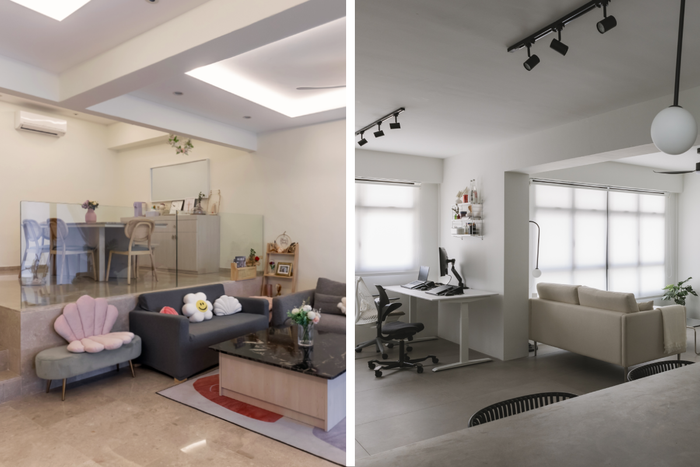The pros, the cons, and whether you should do so.
While most homeowners turn to an interior designer to renovate their home, you can’t deny the appeal of DIY-ing your renovation (by this, we mean renovating without an ID). Having total say over every aspect of your home? A sure-fire way to satisfy anybody’s inner control freak.

Of course, this also means spending a copious amount of time managing contractors, timelines, and personal lives. So, the question we really want to know is: is it really worth it to engage a contractor for a renovation, or is working with an interior designer still the better choice?
To find the answer, we explore what working with contractors is like – by getting the input of two homeowners, Rachel (@racheeng) and Nicole (@xinic.living), who have gone down this road less travelled.
Reasons for choosing to renovate without an interior designer
Rachel (R): Aaron (my husband) and I knew from the start that we wanted to work with a contractor. Both of us had complementary skills that we thought would be useful – Aaron had the skills of handyman, whereas I’ve always liked organising events and designing my own stuff.
We also had a clear idea of what we wanted early on. Both of us grew up in cluttered houses, so for our own home, we agreed that we wanted a clean, tidy space. Knowing this made the process of looking for design ideas much easier.

Rachel and Aaron’s home: a 4-room BTO flat in Bidadari with a minimalist, monochrome theme
Nicole (N): It was actually a family decision to engage a contractor, since we have connections to suppliers and contractors. Plus, my family wasn't really comfortable with the idea of 'extra fees' that you pay an ID – like design and project management fees.
With these connections, and without the extra costs, we thought managing our own renovations would be way cheaper compared to getting an ID to do it.

Nicole and CX’s home: a landed property in Bedok
Preparing for the renovation

R: We spent some time looking for design ideas, but because we already knew what we wanted, nailing the look came quite naturally. The homes that caught our eye were the minimalist ones with monochrome interiors, which to me was as clean and simple as it gets.
We actually didn’t spend too much time looking for a contractor. We’re the type to go more with our gut feeling – I think we only reached out to three contractors in total before deciding on one.

N: We did a few mood boards of what we wanted, but we wouldn't really say that there's an obvious style or look. All we knew was that we wanted something like a mix of scandi-boho, with less carpentry and more loose furnishings because we are maximalists and like to switch things up every now and then.
Oh, and we were also hoping for an open-concept layout to accommodate a bar counter. We have a lot of walls that make the space cramped, and we envisioned tearing down a few walls to open up the space.
What the DIY reno process was like
R: We did a lot of site visits to ensure things were moving smoothly – I think we dropped by every other day! Thankfully, we were staying nearby, and the renovation was during the time when WFH was the default, so we were able to make quick trips during lunch.
N: All these things took up a lot of time, especially since we did not live near our new place and could only visit mostly at night. Juggling that, our wedding (which we were planning during that time), work, and family made us so busy, and it was really stressful.
Pros of engaging a contractor
R: The cost is definitely lower than what you spend working with an ID, which we saw as a huge benefit.

Also, the contractors we worked with had been active in the industry for a long time, so they had the knowledge to advise us on the feasibility of certain works. They can give first-hand advice on these technical matters, unlike an ID who may not always know the groundwork best.
However, because they’ve been in this industry for a long time, they already had their own way of doing things, so it’s not the easiest to get them to adapt to a different style of working.
Cons of engaging a contractor
N: First of all, don’t expect any 3D drawings or visual mock-ups. We literally just got a sketch on paper.
The design proposals also tend to be of the cookie-cutter nature. For our contractor, it looked like they were things that were easy to do, or those that she already knew how to do, instead of catering to our lifestyles.

For instance, I wanted the vanity placed next to the bed because I always apply lotions before going to sleep, and I wanted the bottles within reach. But all she said was that it was impossible, and proposed creating it in a different location that completely disregarded the requirements that I already informed her about.
In the end, my husband and I had to brainstorm and find the solution for her, instead of the other way around. We were the ones who suggested making the wardrobe smaller to accommodate the vanity.

Another thing is that you will really have to spoon-feed them in telling them exactly what you want, right down to the smallest details. Our contractor made a bathroom door without a lock, and we had to tell her to redo because we wanted a lock. After that, we still had to source for the lock ourselves.
Also, because she was a family friend, it was hard to be 100% honest with her. We couldn’t really critique her work or point out defects, since there’s a possibility that it could sour their relationship.
Outcome of the renovation

R: I loved how my house turned out! The experience was almost dream-like – I think it’s because I was the one doing the initial sketches, and seeing our house transform and eventually looking like what we envisioned feels surreal.
Of course, there’s no such a thing as a perfect renovation. There were some parts and workmanship issues that we weren’t 100% satisfied with, but anyway, there’s no way for us to find out if an ID would have done a better job or not. And besides, what matters is how you manage these setbacks.
Explore: Rachel's entire renovation journey
N: In the end, the renovation felt more like a ‘touch up’ instead of an overhaul, because the house remained very similar to the way it was before we moved in.

The workmanship wasn’t great – certain things weren’t straight, and there were splotches of other paint colours that went over carpentry laminates.
We actually went to an ID after the renovation, just to see what could have been. What they proposed was more in line with what we wanted – like hacking walls to improve air flow, making the house look more spacious, and more customisation to suit our living habits.
Ironically, what they quoted me was also less than what I ended up paying for my renovation.
Lessons learnt

R: Overall, it was a learning opportunity for the both of us. After sketching the designs, sourcing for suppliers on our own, and liaising directly with the contractor, we realise that we’re the type who prefer managing things ourselves.
Working with a contractor helped us save on costs, which was a huge benefit to us. But understandably, this option isn’t for everyone – you have to be ready to put in a lot of time and effort, and also be comfortable managing timelines and checking for updates regularly.

N: Before doing up my own place, I helped my family renovate their home with an ID, so I now have experience working with both an ID and a contractor. To me, there was a huge difference, because an ID caters to a homeowner's lifestyle habits, whereas a contractor just executes the work without considering that.
In my opinion, I feel that the most important thing is chemistry with the designer, before price, because you and the person you’re working with need to be aligned to bring the home you want to life.
Renovating with a contractor doesn’t necessarily mean it’s cheaper, because you’ll still end up bursting your budget if you still choose expensive materials. We also had a lot of variation orders that kept getting added to the original quote because of mistakes, or things that were not thought of before. In the end, the price was almost the same as what you’d get with an ID.
Advice to other homeowners

R: For a smoother process, it helps to be very, very clear on what you want before communicating it to your contractor. Not only does it give them a clearer end goal to work towards, it’ll also minimise the back and forth.

N: Our experience was not the best, but we're not saying that all contractors are bad. We're sure that there are good ones out there – you just have to take the time to search for them.
In general, I think only certain types of people can work better with a contractor. For example, my sister is currently renovating her home with a contractor, and her experience is more smooth-sailing as she’s design-savvy and can do her own renders. She also has more time to oversee everything as she’s unemployed at the moment.
But if you don’t have much time or the design know-how, we would not recommend working with a contractor.
So, is it worth it to DIY your renovation?
While Rachel and Nicole had vastly different experiences working with a contractor, the question of whether you should engage a contractor or an ID is ultimately up to you. In most cases, a contractor is cheaper than an ID, but ask yourself this question: are you truly prepared for the amount of time and effort this involves?
If your answer to that is no, you’ll have an easier time working with an interior designer. And finding one will be even easier when it’s done through our platform, because we’ll be able to match you to the right ID based on your style and budget requirements.
Simply click the button below to begin!

 Get a budget estimate before meeting IDs
Get a budget estimate before meeting IDs